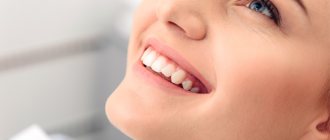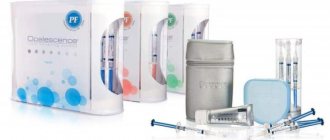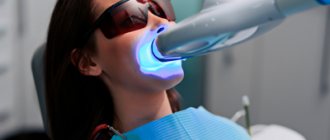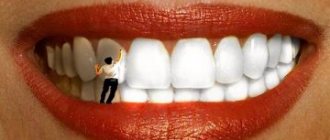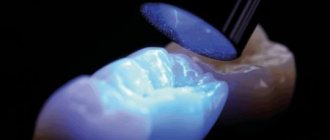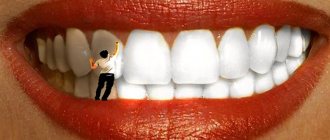From this article you will learn:
- before and after photos,
- teeth whitening Zoom – price 2022.
The article was written by a dentist with more than 19 years of experience.
Teeth whitening ZOOM 4 is one of the professional whitening methods that is carried out in a dental office. The active substance used is 25% hydrogen peroxide gel - in combination with a special “Zoom WhiteSpeed” lamp (Fig. 1-2), which, according to the manufacturer, increases the strength and speed of whitening.
Zoom whitening was developed by the American company DISCUS DENTAL, but LED lamps for it are produced by Philips (the Netherlands). Zoom 4 is already the fourth generation of this system, and before that Zoom, Zoom 2 and Zoom 3 were released in turn. At the moment, only the 3rd and 4th generations of this system are used, which (compared to the previous ones) have become much safer for teeth.
Zoom-4 lamp and whitening kit –
In general, only about 55% of patients have positive reviews of Zoom 4 whitening, and below we will go into detail about the reasons for the negative reviews. For example, the manufacturer’s claimed whitening of teeth by 8 shades in 1 procedure, which lasts for 3-5 years, is more of an advertising ploy. The fact is that the degree of teeth whitening is assessed by the dentist immediately after the whitening procedure, and not a few days later.
But due to exposure to intense light flux, as well as prolonged isolation of teeth from the moist environment of the oral cavity during the procedure, the enamel of the teeth loses moisture, and due to the dryness of the enamel, the teeth initially look much whiter. Within 24 hours, the saturation of the enamel with water will be completely restored, and you will be able to notice that the color of your teeth will no longer be as white as it was immediately after the procedure. But this is not the only problem with the Zoom 3 and 4 systems...
What is photo teeth whitening?
For your information! Photo whitening, or as it is also called “light whitening,” is a fast and safe dental procedure that can whiten tooth enamel by 10-12 shades at a time.
During photo-whitening, a special composition is distributed onto the teeth , the main active ingredients of which are hydrogen peroxide and carmabide.
Activated under the influence of lamp light and penetrating into the deep layers of dentin, they destroy unwanted color pigments.
The type of lamp is selected depending on the condition of the dental bone, soft tissues and natural enamel pigment.
When photobleaching, lamps with the following variations of light radiation are used:
- Ultraviolet lamps - lamps of this type are considered somewhat outdated, since during operation they emit heat and heat tooth enamel.
- Halogen - the light from these lamps is cold, which minimizes tissue trauma.
- LEDs are currently the safest cold-glow lamps.
It is worth noting! The entire lightening procedure takes an average of 1 hour and is carried out in several stages:
- Dental examination. The doctor examines the patient’s teeth and mucous tissues for contraindications. For example, if there is tartar or caries, they will need to be eliminated first and only then proceed to whitening.
- Modeling the desired result . The patient indicates what effect he would like to get from whitening using a special sign. In some clinics, the patient is shown the “before and after” result using computer modeling.
- Protecting fabrics from lamp light . The patient's gums and inner cheeks are covered with a special protective plate. This step is necessary to minimize the likelihood of light or chemical burns.
- Distribution of gel over tooth enamel. As a rule, only the “smile zone” is treated, that is, 10 teeth of the upper and lower jaw that are visible when smiling, laughing and during communication.
- Protect your eyes from lamp light . Both the doctor and the patient wear special protective glasses to prevent retinal burns.
- Applying gel to teeth and whitening . The doctor distributes the gel over the patient’s tooth enamel and turns on the lamp. Exposure time is 10-20 minutes. After this period, the gel is removed with a napkin, and its remnants are removed during rinsing. There can be up to 6 applications in 1 session.
- Checking the result using the Vita scale . After all manipulations with the teeth are completed, the doctor gives the client a mirror and a Vita scale (a strip on which all possible shades of tooth enamel are depicted). This is done so that he can clearly see what results were achieved.
- Consultation on further oral care.
How does Zoom 4 teeth whitening work –
Teeth whitening with the Zoom 4 system is achieved through the simultaneous action of 2 components. The main component of the system is a whitening gel, which contains a 25% concentration of hydrogen peroxide, as well as a special photosensitive activator. The latter accelerates the decomposition of hydrogen peroxide into free radicals when exposed to a light flux of a certain wavelength.
The second component of the Zoom 4 system is the Zoom WhiteSpeed lamp. This is an LED lamp that emits light with a wavelength in the range of 400-505 nanometers. The light flux, acting on the whitening gel applied to the front surface of the teeth, accelerates the decomposition of hydrogen peroxide in it. As a result of this process, free radicals are formed that penetrate the dental tissues, destroying pigment molecules there.
A high 25% concentration of whitening gel + additional exposure to a light source allows you to achieve whitening results of up to 6-8 tones* in just 1 procedure. The duration of the procedure will be only 60 minutes. Whitening stages are carried out three times in a row for 15 minutes, during which new portions of the whitening gel will be applied and the LED lamp will turn on. And at the very end, you will be given an application of remineralizing gel to reduce the adverse effects of whitening on tooth tissue.
Brief and complete video of the Zoom whitening process –
Teeth whitening Zoom 3 and 4: differences
Dental clinics now offer Zoom whitening, which can be performed using either a 3rd or 4th generation LED lamp. Teeth whitening Zoom 3 involves the use of a Zoom Advanced Power lamp (Fig. 5), and teeth whitening Zoom 4 uses a Zoom WhiteSpeed lamp (Fig. 4). The latter has a higher intensity of light flux, as well as the ability to adjust the light intensity during the procedure.
Such characteristics of the WhiteSpeed lamp can reduce the risk of a patient developing pain syndrome (increased sensitivity of teeth), or reduce its intensity. By the way, it should be noted that for Zoom 3 and 4, a whitening gel of the same composition and characteristics is used. Thus, the difference between them lies solely in the functionality of the lamp itself.
Both lamps look almost the same -
Important: an interesting point is that, unlike all other whitening systems, Zoom lamps emit light in the ultraviolet range. The fact is that ultraviolet light itself has a slight bleaching effect. However, other manufacturers of similar whitening systems especially emphasize that their whitening lamps are equipped with a 100% ultraviolet filtration system to avoid negative effects on the oral mucosa (24stoma.ru).
The manufacturer Zoom claims that its lamps have filters that remove all the negative part of the ultraviolet spectrum and produce only safe ultraviolet light. But how true this is and whether this can lead to the development or worsening of diseases of the mucous membrane (for example, leukoplakia) - one can only guess. And therefore, in our opinion, the use of Zoom can be dangerous for smokers, who are already at risk for the development of precancerous diseases of the oral mucosa and the red border of the lips.
What types are there?
Stay up to date! Most dental clinics in the CIS countries offer the following photo-whitening techniques:
- Beyond Polus is a symbiosis of halogen and LED radiation, which makes the procedure safer for enamel. One whitening session usually consists of three cycles of 10 minutes each. The effect lasts up to a year, after which the procedure can be repeated.
- Luma Cool - this technique uses exclusively cold-light LED lamps. This makes it absolutely safe for both teeth and soft tissues. One session consists of three cycles of 8 minutes each. The result lasts for several years.
- Zoom is perhaps the most famous photo-bleaching technique, which is performed using a UV lamp. Ultraviolet radiation produces heat, which is quite detrimental to enamel. But, nevertheless, Zoom gives the most pronounced effect among all the above procedures. Whitened teeth retain their newfound color for up to one and a half years.
After a photo-whitening session, tooth enamel becomes more sensitive, which is why drinking hot and cold drinks is accompanied by unpleasant sensations.
Note! This is a temporary phenomenon that completely disappears in 3-5 days.
The difference between ZOOM and laser whitening –
Whitening Zoom involves the use of the following light lamps... The Zoom-3 uses an “Advanced Power” lamp - with a light wave range from 350 to 400 nanometers, and the Zoom-4 uses a “WhiteSpeed” lamp with light waves in the range of 400-505 nanometers. Thus, the lamp emits light waves not of a specific one wavelength, but a whole beam of waves of different lengths.
The latter, by the way, allows us to call Zoom a technique for photo-whitening teeth. In turn, diode lasers used for laser whitening emit only one strictly defined wavelength, for example, 810 nanometers. At the same time, both methods use a similar whitening gel. We hope that our article on the topic: Zoom-4 teeth whitening was useful to you!
Sources:
1. Add. prof.
, 2. Based on personal experience with whitening, 3. National Library of Medicine (USA), 4. American Academy of Cosmetic Dentistry (USA), 5. https://www.realself.com/, 6. https:// www.usa.philips.com/.
Indications and contraindications
Many things can affect the color of enamel - genetic predisposition, abuse of cigarettes and coloring products, and even treatment with antibiotic drugs.
Indications
You should know! The desire to make your smile more aesthetic is the main indication for the procedure.
Photo whitening will help you if your teeth:
- They have uniform pigmentation without light and dark stripes and other inclusions.
- Well formed and have naturally strong enamel without grooves, chips or cracks.
Contraindications
You will have to refuse the photobleaching procedure if you are limited by one of the following factors:
- Pregnancy and lactation period.
- Age under 18 years.
- Thin and sensitive enamel.
- Caries.
Teeth whitening Zoom 4: reviews
As we said at the beginning of the article, only about 55% of patients were satisfied with Zoom whitening for its fast and good results. However, the remaining patients regretted their choice and said that they would never undergo this procedure again and would not be able to recommend it to anyone. Let's figure out what this was connected with (all reviews are unique and taken from the site https://www.realself.com/zoom-teeth-whitening/patient-reviews).
Severe shooting pains in teeth -
Reviews of Zoom whitening from people with hypersensitive teeth usually contain complaints of sharp shooting pains in the teeth, which can occur both during the whitening procedure and for several days after its completion. However, many patients who have never previously suffered from hypersensitivity also report the appearance of severe pain.
Reviews describe many cases where patients had to ask the doctor to interrupt the procedure due to unbearable pain. In this case, the lamp was turned off, and the whitening gel was immediately washed off from the teeth. Patients were prescribed strong analgesics and applications with enamel-strengthening gels. Despite the fact that we present negative reviews below (because this will allow you to understand what you may encounter) - we objectively recognize that 55% of patients were satisfied with Zoom.
Examples of reviews –
- Reviewed January 26, 2022 “Within an hour I began to experience terrible shooting pains that lasted up to 30 seconds each time.
I had to leave my job. By the time I returned home, I had constant pain in all my teeth. I moaned and rolled on the sofa until the evening, and in the evening I went to the dentist's office. The doctor rubbed some kind of anesthetic gel into my teeth and prescribed a strong painkiller. But the pain did not disappear, I did not sleep all night. The pain went away only after 16 hours. Seriously, if your teeth have even the slightest sensitivity - I would not recommend this ever. It was the most painful procedure of my life. My experience may not be everyone's experience, but for me it was terrible. So I wanted to warn people so they don't experience the same thing I did."
- Reviewed June 10, 2016 “Let me start by saying, you can't even imagine the pain that comes with Zoom. Before the procedure, the dentist's exact words were: "you may feel a little sensitivity in 1-2 teeth." This didn't bother me because I don't have sensitive teeth. The first 10 minutes of the procedure went without any worries. But over the next 30 minutes there were terrible stabbing sharp pains in each tooth. It is as if the nerves were exposed to an electrical current. Yes, my teeth are several shades whiter, but I will never repeat this procedure or recommend it to anyone.”
- Reviewed February 18, 2016 “6 hours later I am still in a lot of pain and the painkiller Advil isn't even helping. I can't eat anything, take a sip of water or even talk. This is terrible, I will never do this procedure again. Yes, my teeth look whiter, but it's not worth the pain I'm going through."
- Review dated October 3, 2016 “The pain appeared about 10 minutes after the end of the session. At first it was mild, but after a couple of hours I was in bed, drinking a strong painkiller. I can't work because I can't even talk. Air entering through my mouth when I speak causes severe pain. I tried to suck the bread and even that caused pain. I'm so upset, it's killing me! I wouldn't recommend it to anyone! I can imagine how harmful this procedure is for my teeth if they react this way. Save your money and yourself!”
- Review January 30, 2014 “I went for my regular checkup and the dentist said my teeth were perfect for whitening.
I had noticed yellowing of my teeth before, but had never had professional whitening done. They told me that “there would be some tooth sensitivity,” but I was not prepared for the absolute excruciating pain that I experienced already during the procedure, and it only got worse from there. 10 minutes after the start of the procedure, I experienced the first severe shooting pains. By the end of the whole procedure, my eyes were full of tears. The doctor coated my teeth with fluoride and gave me ibuprofen, but none of that worked. I can't eat or even move my mouth because... any touch of the teeth causes excruciating pain in them. I can't stop crying even though I left the clinic two hours ago. My teeth have never been this sensitive, so it's not just my body overreacting. I wish I had used whitening strips or something else. If you think you may have even the slightest tooth sensitivity, the strips will work infinitely better and cause far less pain than the Zoom procedure."
Conclusions: you should not undergo a professional whitening procedure in principle if you periodically experience pain in your teeth due to thermal and mechanical stimuli (i.e., there is increased sensitivity of the teeth). In other cases, the risk of developing acute pain will be significantly lower. Zoom-4 uses the latest generation of WhiteSpeed lamp, which allows during the procedure, if necessary, to reduce the intensity of the light flux, which somewhat reduces the severity of pain.
The degree of whitening may be lower than expected -
As we said above: teeth lightening by 6-8 shades in 1 Zoom procedure is not very true.
The dentist will measure your teeth color using a special scale (for example, Vita or others) - before and immediately after the whitening procedure. The problem is that teeth lose a lot of moisture during whitening, and overdried teeth always look whiter. Therefore, when the dentist shows you the change in tooth color immediately after the procedure, you should know that the resulting tooth color will change within 1-2 days. This will happen because the hard tissues of the teeth, overdried during the procedure, will gradually become saturated with moisture, which will lead to a decrease in the degree of whiteness of the teeth obtained immediately after the Zoom whitening procedure.
Determining the shade of teeth using a special scale -
If your dentist insists on guaranteeing that your teeth will be 6 or 8 shades lighter, then ask him to measure the color of your teeth not immediately after the procedure, but the next day, and ask him to include this clause in the contract for the possibility of a refund. Believe me, the dentist’s mood will immediately change... You can get a fairly good result only if your teeth are really yellow. If your teeth are already quite light, but you want to make them even whiter, keep in mind that the visible effect obtained immediately after the procedure will be practically unnoticeable after 1-2 days.
Examples of reviews –
- Reviewed December 27, 2016 “I had Zoom teeth whitening twice because... the first time my teeth looked no better. My teeth didn't look like the ones in the Zoom commercial. My before and after photos look almost identical (this was after the first time, but even after I did it the second time - the results were about the same). It’s not worth the cost and it’s not worth the pain I’ve endured.”
- Reviewed June 11, 2015 “Unless you have super yellow teeth, you won't notice a significant difference. Unless the whitening doctor only treats half of your teeth so you can compare the difference. Don’t be fooled by doctors who will guarantee you super results, because... They themselves cannot predict what the effect of whitening will be on each individual patient.”
Why the effect may not last long -
Although dentists claim that Zoom teeth whitening can give results for 3-5 years, this is basically advertising again. The problem with quickly lightening teeth in 1 procedure is the high rate of “rebound” of tooth color. And there is a dependence: the shorter the procedure, the faster your natural teeth color returns. That is why with whitening systems, which involve daily procedures for 30-60 minutes for 10-20 days, the achieved effect lasts longer.
And that is why the manufacturer Zoom also produces home whitening systems, the regular periodic use of which is necessary to maintain the result. And immediately after the procedure, the dentist will always recommend that you buy such a home support system Zoom. As a result, the final cost of Zoom whitening will be 5-6 times higher when compared with high-quality home whitening systems such as “Opalescens”.
A 2013 publication by Basson, which reviewed the results of 49 clinical studies conducted from 1998 to 2011, states that professional whitening achieves initial improvement in tooth color—only slightly better than at-home whitening systems. Moreover, when measuring the color of teeth 4 weeks after the end of the whitening procedure, professional whitening showed a significantly greater relapse of tooth color (compared to home whitening).
Examples of reviews –
- Reviewed August 27, 2013 “A few weeks before getting veneers, I had a Zoom teeth whitening treatment as recommended by my dentist. I didn't feel anything during the treatment, but an hour after leaving the clinic I began to experience excruciating pain that lasted for about eight hours. Although my teeth became significantly whiter - this whiteness faded within 1 month. Now more than 4 months have passed since the treatment, and I can hardly see the difference between “before” and now. I will no longer undergo this procedure because I believe that it is not worth the pain and the cost.”
- Review dated April 20, 2014 “The result obtained is not worth a penny. So, the almost invisible effect of Zoom disappeared after 2 days. I had better results even after using regular at-home whitening strips. In general - never again, a waste of money."
Risk of chemical burn to gums –
Before a whitening procedure, your dentist will always place what is called a “liquid rubber dam” on your gums, which is supposed to seal off 25% of the hydrogen peroxide from your gums. Sometimes dentists do not properly isolate the gums and lips from contact with the whitening gel, which leads to the development of a chemical burn. The problem is that scarring of the gums and lowering of its level can occur, exposing the surface of the tooth root.
What does a gum burn look like after Zoom?
Review example –
- Reviewed February 3, 2022 “The day after the procedure, the entire inside of my lower lip was white and very sore. It looks like my entire bottom lip was burned off by the hydrogen peroxide. I can't drink hot drinks, eat anything spicy, or brush my teeth because they all cause severe pain when they touch my lips and gums. Due to the fact that I can’t brush my teeth, they are no longer so white. I wish I had never done this."
Negative effects on tooth tissue –
If they tell you that professional whitening does not lead to demineralization of dental tissues (loss of calcium), then you should not believe it. Clinical studies "Sighiand Denry" (1992), "McCracken et al." (1996) showed that chemical bleaching leads to a decrease in enamel strength and wear resistance to abrasives and chemicals. And the higher the concentration of hydrogen peroxide is used, the higher the degree of demineralization of enamel and dentin.
That is why the manufacturing company Zoom recommends that all patients undergo remineralization therapy not only after the whitening procedure, but also before it begins. In addition, the contraindications to Zoom include a group of patients with weak resistance of tooth enamel to acids and mechanical stress (i.e., patients with weak mineralization of tooth enamel), which once again confirms that whitening has a negative effect on the hard tissues of teeth.
Review example –
- Reviewed October 16, 2014 “I have always had white teeth, but I wanted them to be even whiter. So I did Zoom. It was the worst experience. I have never had tooth decay or gum disease. I had severe pain after the procedure. But the most important thing is different... I began to notice that the enamel began to collapse (peel off) from the front surface of my teeth.”
Commentary on the review - if a dentist recommends a whitening procedure for a patient with weak enamel mineralization, then destruction of its surface layer is indeed possible. To reduce the risk of tooth decay, teeth are treated with “Relief” gel based on amorphous calcium phosphate before and after Zoom. The use of a gel is an attempt to compensate for the negative effects of whitening on tooth tissue, which will certainly reduce the negative effects of exposure to high concentrations of hydrogen peroxide on tooth tissue.
Pay attention to the following before and after photo (Fig. 17). If you look closely, in the first photo taken before the Zoom procedure, there are white chalky spots on the teeth. Such stains indicate insufficient mineralization of tooth enamel, and as a result, poor resistance to chemical and mechanical factors. Because The dentist neglected the rules for selecting patients for this procedure - the patient received not only uneven tooth color, but also a predisposition to the development of caries and increased enamel abrasion.
Increases the risk of fillings falling out –
Clinical studies by Della Bona et al. 1992, Tiunsakeretall 1990, Titleyetall 1991 - showed that chemical bleaching with hydrogen peroxide disrupts the bond between tooth dentin and filling materials (both light composites and glass ionomer cements). As a result, the marginal fit of the filling to the tooth tissue deteriorates, which can lead to the development of caries at the filling/tooth interface and loss of fillings.
Advantages and disadvantages
The procedure has gained worldwide fame precisely thanks to its extensive list of advantages :
- Quick results - just one hour-long session and teeth become 10-12 shades lighter.
- Durability – the result lasts from 1 to 3 years.
- safety – compared to older enamel lightening methods.
Keep in mind! But it was not without its drawbacks:
- Temporarily makes teeth more sensitive - this causes discomfort during meals.
- Does not lighten fillings, veneers, dentures and crowns - they will need to be changed after whitening.
- It is quite expensive - which for many is a decisive factor for refusal.
Should I use home whitening products?
It is advisable to use homemade compositions to preserve the whitening results for a long time. But these should not be folk remedies, but professional ones, selected by your dentist. It is necessary to start using such compositions no earlier than 3 months after the professional procedure. It is better if the same system is used that was used in the clinic - for example, ZOOM or Amazing White - these brands provide formulations for use at home. But for this you will need to make individual mouth guards in which the active gel will be placed.
Whitening at home is especially effective for maintaining results after a professional procedure.
How to maintain the result after photobleaching?
After the tooth enamel whitening the doctor conducts a consultation with the patient and gives him a list of recommendations for maintaining a new snow-white smile in its original form.
You should know! To maintain tooth enamel in a clean form, the patient should adhere to the following tips:
- For the first 1-2 weeks, refrain from eating coloring foods and drinks (red and blue berries, tea, coffee, lemonade).
- In the first 3 days, avoid eating excessively hot and cold foods, in order to once again cause yourself discomfort.
- Replace your usual toothbrush with a softer one.
- Buy toothpaste with a high content of fluoride and calcium.
- Buy floss (dental floss) and carry it with you everywhere to get rid of food debris if you are away from home.c
If you cannot deny yourself the pleasure of drinking coffee, juice or lemonade, drink drinks through a straw.
How safe is the technique?
The use of modern technologies and lightening compounds in safe concentrations made the procedure harmless. It is important to undergo appropriate training, identify possible contraindications, and assess the current condition of the enamel. In general, if the doctor follows the technology and uses high-quality equipment, any risks of complications remain at a negligibly low level.
Here are some more compelling reasons for the safety of laser technology:
- unlike a light lamp, a laser beam provides a targeted and impulsive effect, which significantly reduces the likelihood of a thermal burn and makes the procedure as comfortable as possible for the patient,
- the lightening composition used penetrates deep enough into the enamel layer and at the same time acts quickly, which protects the surface of the teeth from excessive drying,
- The laser device has various setting modes, which allows you to control the intensity of the effect. The set also includes various attachments, the choice of which depends on the current state of the enamel and the individual characteristics of its structure,
- After the session, patients also experience hyperesthesia, but in the case of a laser, the unpleasant sensations are much less intense, as after other methods of in-office whitening.
The photo shows teeth before and after the whitening procedure.
The technology involves the use of a gel with a fairly powerful active ingredient. Therefore, if there are problems with the enamel, it is better to refrain from the procedure. Keep in mind that some pathological phenomena can only be identified by a professional dentist, so before proceeding with bleaching, the doctor should conduct a visual examination and assess how healthy the tissue is and ready for bleaching.
average price
Need to know! The price for the photobleaching service is determined depending on the following factors:
- City – in Moscow and St. Petersburg prices are significantly higher than in the regions.
- The reputation of the clinic - the more highly qualified doctors and better equipment the clinic has, the higher the price tag. This is exactly the case when the price justifies the quality.
- Methodology used. For photo whitening Zoom the price tag varies from 15,000 to 25,000 rubles, for Beyon Polus - from 10,000 to 20,000 rubles, and for Luma Cool - from 6,000 to 14,000 rubles.
Zoom teeth whitening: price
The cost for Zoom teeth whitening in 2022 will be about 15,000 rubles in mid-price clinics. Moreover, the cost will not depend on the generation of the whitening lamp. And in any case, Zoom 3-4 generations will use the same version of the clinical whitening kit, which will contain 25% whitening gel and many different devices.
There are 2 options for sets (Fig. 6). The first option is Zoom CH Single Kit, which is an individual kit for 1 patient; its cost is about 10,000 rubles. The second option is a set for 2 patients, the cost of which will be about 17,000 rubles. Therefore, when they offer you Zoom whitening costing 8,000 rubles, it will probably be a scam. In this case, most likely, whitening gel and consumables from a cheaper manufacturer will be used, or even fake “Zoom” kits from Chinese manufacturers.
The maximum price for Zoom whitening in Moscow reaches 30,000 rubles. When you decide whether to buy this procedure or not, keep in mind that after the procedure in the clinic, you will still have to additionally buy home teeth whitening Zoom (Fig. 7). This set is designed to support results and is available in two versions: Zoom “Nite White” or “Day White”.
These kits contain whitening gel for use at home. Only the purchase price (cost price) of such kits for maintenance therapy will be about 8,500 rubles, but in the clinic you can only buy them with a corresponding additional markup. Therefore, consider what the final price for Zoom whitening will be...
Reviews about the procedure
Below are some reviews. If you have something to say, leave your feedback in the comments below the article, it will be useful to our readers.
Marina, Moscow.
Teeth are my sore subject. They are naturally yellowish, plus I simply cannot imagine myself without coffee. I was thinking about getting veneers or whitening my teeth. In the end, I chose the second one and did not regret it. It’s been 3 months since I became the owner of a Hollywood smile! Despite my enormous fear of dentists, I endured the procedure calmly - I just lay there while the lamp did its job.
Rinata, Novosibirsk.
My daughter had her teeth photobleached - she wanted to look 100% at her prom. My teeth certainly became whiter, but terrible sensitivity of the enamel appeared. For the first week after going to the clinic, my daughter could not eat or drink anything without wincing in pain. She said that she liked the effect, but she was no longer ready to make such sacrifices for the sake of beauty. Now maintains the result with professional cleaning.
Some tips
Before you make a white background in a photo, you need to capture the frame correctly. Our simple tips will help you make it perfect:
- Look for more white surfaces: wall, table top, carpet, refrigerator, cabinet door, window and more.
- Try to stick to minimalism. The fewer objects there are, the more aesthetically pleasing the photo will look.
- Take a close look at the details that will be shown in the photo. They should successfully resonate with each other.
Consolidate the result
The teeth whitening procedure is carried out at intervals from 6 months to 2 years. To reduce the number of sessions, you should take all preventive measures recommended by your dentist.
You can maintain the whiteness of your tooth enamel after completing the whitening procedure by:
- using high-quality and effective toothpastes that are designed to care for the entire oral cavity;
- removal of dental plaque in the clinic several times a year (preferably every 4 months);
- limited consumption of products that contain coloring pigments: strong tea, black coffee;
- quitting smoking cigars, cigarettes, hookah.
How much does a snow-white smile cost?
How much will laser whitening cost? The answer to this question directly depends on the type of equipment used, the pricing policy of the clinic and the region of treatment. On average, the price of one session in Moscow ranges from 20 to 30 thousand rubles. The cost includes treatment of only those teeth that fall within the smile zone.
Overall, this is a safe and effective method that allows you to quickly become the owner of a snow-white Hollywood smile. It is only important to take a responsible approach to finding a good clinic and an experienced specialist, diagnose the condition of hard tissues in advance, and identify possible contraindications and the root cause of tooth darkening.
- Burgonsky V.G. Lasers in dentistry, 2009.
In what cases is it better to refuse the procedure?
The use of the technique is permissible if there are no accompanying pathological processes in the oral cavity. So, for example, the procedure is not performed for chronic diseases, immune disorders, or carious processes. Increased sensitivity of the enamel is also a contraindication. Here are a few more strict restrictions on brightening your smile this way:
- age up to 18 years,
- allergic reactions to components in the activator gel,
- oncological pathologies,
- During pregnancy and breastfeeding,
- extensive carious cavities, the presence of old fillings that need to be replaced,
- poor hygiene, heavy plaque and hard deposits - before the procedure you will have to undergo preventative cleaning at the dentist,
- the presence of erosion, cracks and chips,
- fluorosis - the technique may turn out to be ineffective, like other methods. To solve the problem, you can resort to installing veneers.
The photo shows dental fluorosis.
Some of the above contraindications are relative. This means that before the whitening course you will have to undergo preparation: heal all carious holes, replace old fillings with new ones, restore enamel, stop inflammation, remove plaque and deposits.
What does intracanal whitening mean?
Endo-whitening involves lightening the tooth from the inside. This is an intracanal treatment that occupies a separate niche in aesthetic dentistry and allows you to achieve a lasting effect in cases where other methods are powerless.
“I had a dead tooth without a nerve, which just falls into the smile zone. The dentist suggested performing intracanal bleaching. They immediately explained to me that this was the only option, or veneers. I chose to lighten it because there was no money for veneers. The tooth became very bright. He, of course, stands out a little from the rest, but not so brightly. I was satisfied, especially since I was counting on a worse result.”
Dinara10, Moscow, from correspondence on the woman.ru forum
The photo shows intra-canal teeth whitening.
The technique involves introducing the active substance directly into the canals of the tooth and is usually used for pulpless units, the darkening of which occurs after removal of the nerve. To begin with, the specialist diagnoses the cause of the color change, after which he removes the old filling, removes tissues affected by caries, if any, and introduces a lightening composition into the free space. At the final stage, the tooth is covered with filling material. Repeat sessions are usually required after 1 and 2 weeks. Only after achieving a lasting result will a specialist place a permanent filling.
